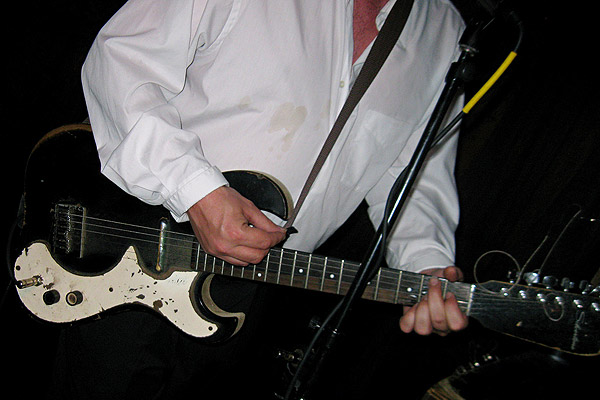
It's been a tough run for Sears lately, as Brigid Sweeney detailed in her excellent Crain's piece on the company's past and present. What once made the company great—bringing a cornucopia of inexpensive products to virtually everywhere—has been conquered by the infinite Sears catalog of the Internet. Today, a friend (h/t @nocoastoffense) pointed me to a nice essay about one small but important part of that early legacy of making commercial inroads down the backways of America: how the Sears catalog, and its cheap guitars, gave Delta bluesmen the tools they needed to revolutionize American music:
The new breed of Delta musicians needed an instrument that was affordable, portable, and capable of producing a wide variety of musical timbres. The guitar could provide harmonic support, rhythmic propulsion, and enough sustain to draw out the long melismatic lines of African-American field hollers. A guitar played with a slide could reproduce the characteristic whine of the single-string didley-bow—a homemade instrument, cobbled together from boards, wire, and nails, that served as the first instrument for many Delta musicians.
[snip]
Guitar quality kept improving while the price kept going down. Soon sharecroppers throughout the Delta were ordering guitars from Sears in hopes of supplementing their income on weekends. The catalog is frequently mentioned in the biographies of Delta bluesmen. In 1930 Muddy Waters purchased a used Stella, most likely originally purchased from the catalog, and began playing gigs. He quickly earned enough money to order a brand new guitar from Sears. B.B. King learned the rudiments of the instrument through an instructional book he ordered from the catalog. And of course, blues musicians weren’t the only ones to profit from the availability of cheap guitars: White country artists such as Roy Clark would get their first instrument from the same catalog that black bluesmen like Son Thomas would.
Not to mention Chet Atkins, whose first guitar was a now-legendary acoustic Sears Silvertone. In short, a Chicago company sold cheap guitars that could replace both the banjo and the didley-bow (and, with practice, could provide a decent rhythmic accompaniment as well), many manufactured in Chicago. A generation later, it came back up the Mississippi as the musical genre that defined the city.
But Delta bluesmen weren't the last demographic that would need cheap, loud guitars. Once the sound of the electric guitar became that of American music, teens in garages all over started picking up axes, and Sears was there to supply them:
Joe Fisher, 38, was a buyer for musical instruments at Sears. Nathan Daniel, 51, wants Sears to sign on with the Danelectro guitar line but Fisher would not be sold. He told Nate that without an amplifier included, no deal. So Fisher and Daniel put their heads together and come up with the "Electric guitar and carrying case with built-in 5-in speaker and amplifier." It would be a piece of the cheapest material available for the body, masonite. Stapled to the flat sides, spray painted and edged with vinyl. There's the body. According to Nat, bodies don't matter in an electric guitar (in direct opposition to the ideas of Les Paul, who believed a fine electric guitar should be made of fine woods and weigh more than a sack of fine potatoes). Nat put all his attention into the neck, and here no expense was spared. His pickups were odd then and now, not because of the lipstick tubes, but because he wired them in series. This, they say, is what produced the unique Dano/Silvertone sound now proudly owned by collectors and still played by some of the world's finest guitar players.
The "lipstick tubes" were, at first, literally lipstick tubes: surplus lipstick tubes used to house the magnets in the pickups as a cost-saving measure, to which Silvertones' jangly sound is credited. Here's how rockabilly artist Dexter Romweber describes his:
Silvertones are fascinating things. Other guitars are just way too clean for me. There are other artists that I like that play Gibsons and Fenders… but in terms of what I do, for me, Silvertone's where it's at. I love the sound I get out of that baby…. At other times I was using other guitars in the studio, but the 1448 has a sound that I always compared to an organ. It's a blues sound, it's a raw sound, it's a bassy sound, and like I said… it's not too clean.
(Cat Power bought her first guitar, a cheap Silvertone, because she had a crush on Romweber.)
Another cost-saving measure made the Silvertone's sound even more raw and appealing:
On guitars with more than one pickup, Danelectro used "concentric" stacked knobs. In order to save money, the same generic three-way toggle switch found in the single-pickup guitars was used as a pickup selector switch. This is the real reason Danelectro guitars had their pickups wired in series, producing a big punchy sound with more output and midrange than individual pickup settings and eliminating hum. Parallel wiring (as used by virtually all other manufacturers) would have required a slightly more expensive switch!
Here's a diagram and a bit more on how that works as compared to the legendary Les Pauls:
These classic Danelectro-made guitars used series wiring. When the three-way switch is in the middle position and both pickups are on, the current flows through one and then the other, i.e., in series. This results in a rather strong, ballsy sound. By contrast, a Les Paul's two pickups are wired in parallel. The resultant sound is less strong, but has a harmonic richness.
Elvis Costello used Silvertone guitars on much of When I Was Cruel:
The Danelectro/Silvertone guitars not only were, thanks to their price and the reach of Sears, the first guitars of many musicians, their budget make created a specific sound at the heart of garage rock: its own form of blues, for a new generation.
Photo: the_toe_stubber (CC by 2.0)


